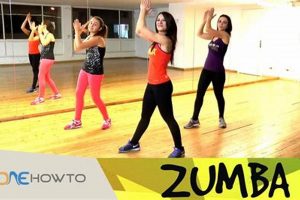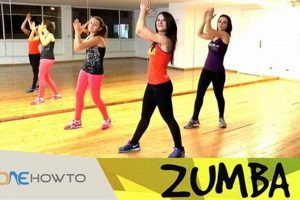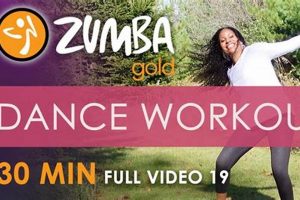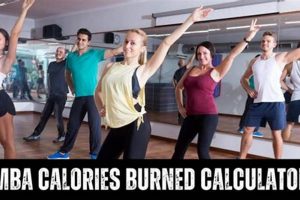A popular group fitness class blends Latin rhythms and easy-to-follow moves to create a dynamic exercise experience. Participants engage in a structured program designed to elevate heart rate and improve overall fitness levels in a set timeframe. The sessions are often high-energy, promoting a fun and engaging atmosphere for individuals of varying fitness backgrounds.
The importance of this type of fitness regimen lies in its ability to offer a comprehensive cardiovascular workout while improving coordination and potentially aiding in weight management. Its origins trace back to the desire to create a more enjoyable and accessible form of exercise, moving away from traditional, sometimes monotonous, workout routines. The combination of dance and fitness has proven to be an effective motivator for sustained physical activity.
The subsequent sections will delve into the specific elements that constitute this fitness approach, including the typical structure of a session, the fitness benefits derived from regular participation, and considerations for individuals seeking to integrate this activity into their overall wellness plan. Further discussion will cover modifications and adaptations to accommodate various fitness levels and physical limitations.
Guidance for Optimal Zumba Experience
The following offers guidance to maximize benefits and minimize risks associated with participation. Adherence to these points can enhance overall effectiveness and safety.
Tip 1: Hydration is Paramount: Adequate fluid intake before, during, and after a session is crucial to prevent dehydration and maintain optimal performance. Water is generally sufficient, but electrolyte replacement may be considered for prolonged or intense activity.
Tip 2: Footwear Selection: Appropriate footwear is essential for stability and injury prevention. Cross-training shoes that provide adequate support and cushioning are recommended. Avoid shoes with excessive grip that may hinder movement.
Tip 3: Warm-Up is Non-Negotiable: A thorough warm-up period, including dynamic stretching, prepares the muscles for activity and reduces the risk of strain. Skipping this step can increase vulnerability to injury.
Tip 4: Listen to the Body: Participants should remain mindful of their physical limitations and modify movements as needed. Pushing beyond ones capacity can lead to overexertion or injury. If pain is experienced, cease the activity immediately.
Tip 5: Gradual Progression: Newcomers should gradually increase intensity and duration. Starting at a moderate level and progressively increasing the challenge allows the body to adapt safely and effectively.
Tip 6: Cool-Down and Stretching: A cool-down period, including static stretching, aids in muscle recovery and reduces post-exercise soreness. Holding each stretch for 20-30 seconds promotes flexibility and reduces muscle tightness.
Tip 7: Instructor Guidance: Pay close attention to the instructor’s cues and instructions. Understanding proper form and technique enhances effectiveness and minimizes risk of injury. Seek clarification if needed.
Effective participation requires adherence to safety principles and awareness of individual limitations. These practices contribute to a more positive and sustainable fitness experience.
The concluding segment will address frequently asked questions and provide a comprehensive summary of the key aspects discussed.
1. Calorie Expenditure
Calorie expenditure represents a fundamental aspect of physical activity, directly impacting weight management and overall metabolic health. Within the context of a structured fitness session, such as a 60-minute session, the number of calories burned is a significant indicator of the workout’s intensity and potential benefits.
- Intensity Level and Metabolic Rate
The intensity of the dance movements directly influences metabolic rate. Higher-intensity routines, characterized by faster tempos and more complex sequences, elevate heart rate and increase oxygen consumption, leading to a greater caloric deficit. Conversely, lower-impact sessions, while still beneficial for cardiovascular health, may result in a lower overall calorie burn.
- Individual Physiological Factors
Individual physiological factors, including body weight, age, sex, and resting metabolic rate, play a crucial role in determining the number of calories expended during the same session. Individuals with higher body weights or muscle mass generally burn more calories than those with lower weights or less muscle. Similarly, age and sex influence metabolic rate, with younger individuals and males typically exhibiting higher rates.
- Impact of Muscle Mass
While primarily a cardiovascular activity, the engagement of various muscle groups contributes to caloric expenditure. Routines that incorporate strength-based movements, even subtly, can increase muscle activation and, consequently, enhance calorie burn. Strengthening workouts alongside cardio will help burn calories in a healthy way.
- Post-Exercise Oxygen Consumption (EPOC)
The “afterburn” effect, also known as Excess Post-exercise Oxygen Consumption (EPOC), contributes to overall calorie expenditure. High-intensity sessions elevate EPOC, meaning the body continues to burn calories at an elevated rate even after the workout concludes. This residual calorie burn can contribute significantly to weight management efforts.
In summary, calorie expenditure during a 60-minute session is a complex interplay of intensity, individual physiology, muscle engagement, and post-exercise metabolic effects. Awareness of these factors enables participants to make informed choices to optimize their fitness goals and track the effects of their fitness workouts.
2. Cardiovascular Enhancement
Cardiovascular enhancement represents a core physiological benefit derived from consistent participation in rhythmic exercise. The effect of consistent dance workout sessions on the circulatory system is noteworthy, contributing to improved health markers and overall well-being.
- Improved Aerobic Capacity
Regular participation leads to an increase in aerobic capacity, as measured by VO2 max. This improvement reflects the body’s enhanced ability to utilize oxygen during sustained physical activity. Individuals experience reduced breathlessness during exercise and improved endurance for daily activities. This also helps the body in the transportation of oxygen and nutrient in a very efficient manner
- Reduced Resting Heart Rate
Consistent cardiovascular exercise results in a lower resting heart rate. This indicates increased efficiency of the heart, as it pumps more blood with each beat. A lower resting heart rate is associated with reduced risk of cardiovascular disease.
- Improved Blood Pressure Regulation
Participation can contribute to improved blood pressure regulation. The rhythmic activity promotes vasodilation, leading to reduced peripheral resistance. This can be particularly beneficial for individuals with hypertension or pre-hypertension, improving their overall quality of life.
- Enhanced Lipid Profile
Regular involvement has a positive impact on lipid profiles, including increases in high-density lipoprotein (HDL) cholesterol and decreases in low-density lipoprotein (LDL) cholesterol and triglycerides. These changes contribute to a reduced risk of atherosclerosis and coronary artery disease.
These cardiovascular benefits collectively contribute to a reduced risk of heart disease, stroke, and other cardiovascular-related ailments. The structured intensity and continuous movement within the program make it an effective modality for promoting cardiovascular fitness across various age groups and fitness levels, allowing the heart to work smoothly.
3. Muscle Engagement
Muscle engagement during a 60-minute dance fitness session is a critical factor influencing its overall effectiveness and benefits. Although often perceived primarily as a cardiovascular activity, the routine inherently recruits various muscle groups, contributing to strength, endurance, and body composition improvements.
- Core Stabilization and Postural Control
The core muscles, including the rectus abdominis, obliques, and transverse abdominis, are continuously engaged to stabilize the spine and maintain proper posture throughout the workout. Dynamic movements require constant core activation to control balance and prevent injury. In reality this translates into improved posture outside of the workout and decreased risk of back pain. The result of a strong core during the 60-minute work out is a solid foundation for executing steps properly and safely.
- Lower Body Strength and Endurance
Movements such as squats, lunges, and grapevines target major lower body muscle groups, including the quadriceps, hamstrings, glutes, and calves. Repetitive execution of these movements enhances muscular strength and endurance in the lower extremities. For example, repeated squat-like motions within the dance sequences build strength in the quadriceps and glutes, contributing to improved lower body power and stability. Over the course of 60-minutes, the repetitive motion will help to develop muscular endurance and help maintain proper form.
- Upper Body Activation and Coordination
While predominantly lower-body focused, upper body movements and arm patterns engage the shoulders, back, chest, and arms. These movements contribute to overall coordination and upper body toning. The use of rhythmic arm movements helps to increase heart rate and caloric expenditure, adding to the comprehensive nature of the exercise and it also helps the engagement and coordination of the whole body during a 60-minute workout.
- Proprioceptive Enhancement and Neuromuscular Control
The dynamic and often complex movements necessitate constant adjustments and adaptations, enhancing proprioception and neuromuscular control. These improvements translate to better balance, coordination, and agility in everyday activities. Consistent participation reinforces neural pathways, improving the body’s ability to react quickly and efficiently to changes in environment and body position. The brain gets constant feedback which helps the muscles react quicker during and after the 60-minute workout.
Muscle engagement within a 60-minute dance fitness session extends beyond simple caloric expenditure, and the integration of muscles working together during the entire 60 minutes to contribute to comprehensive physical conditioning, impacting strength, stability, and neuromuscular coordination. This multi-faceted engagement makes it an appealing and effective exercise modality for diverse fitness goals.
4. Choreography Complexity
Choreography complexity stands as a significant determinant of the accessibility, intensity, and overall appeal of a 60-minute dance fitness session. The level of intricacy and coordination demanded by the dance routines directly impacts participant engagement and physiological response.
- Skill Acquisition and Learning Curve
The level of choreography complexity dictates the skill acquisition required and the subsequent learning curve for participants. Routines with simpler, repetitive movements are generally easier to learn and execute, making them more accessible to beginners or individuals with limited dance experience. Conversely, more intricate choreography demands greater coordination, memory, and practice to master. The routines help to improve learning skills and improve memorization skills and overall cognitive processing.
- Intensity Modulation and Physiological Response
Choreography complexity influences the intensity and physiological demands of the workout. Complex routines necessitate greater cognitive effort and neuromuscular coordination, potentially elevating heart rate and calorie expenditure. However, overly complex choreography can lead to frustration and improper form, increasing the risk of injury. An instructor should consider the group and the skill level of the group to make the choreography appropriate for the 60-minute time frame.
- Participant Engagement and Motivation
The level of challenge presented by the choreography directly affects participant engagement and motivation. Routines that are too simple may lead to boredom and disinterest, while those that are excessively complex can result in frustration and discouragement. An optimal level of challenge keeps participants engaged and motivated, fostering a sense of accomplishment and promoting continued participation. Choosing the right level of choreography will greatly help participation numbers and make the fitness session much more enjoyable.
- Adaptability and Modification for Diverse Fitness Levels
The adaptability of the choreography is crucial for accommodating diverse fitness levels and physical limitations. Experienced instructors modify routines to suit the needs of different participants, offering variations and progressions to increase or decrease the challenge. This ensures inclusivity and enables individuals of varying abilities to participate safely and effectively in the class. A talented and experienced instructor will modify moves for participants to help them grow in their fitness journey.
The choreography complexity of a 60-minute dance fitness session represents a crucial element influencing its effectiveness and overall appeal. Striking a balance between challenge and accessibility is essential for maximizing participant engagement, promoting sustained adherence, and ensuring safe and effective participation for individuals of varying fitness levels.
5. Participant Adaptation
Participant adaptation is a critical determinant of the sustained effectiveness of a 60-minute dance fitness program. The initial physical condition, skill level, and any pre-existing health conditions directly influence an individual’s ability to safely and effectively engage with the demands of the routine. As such, adaptation to the increasing intensity and complexity of the program is essential for realizing its potential benefits while minimizing the risk of injury. For instance, a beginner may initially struggle with the speed and coordination required for certain dance steps, while an experienced participant might find the same routine insufficiently challenging. The importance of this adaptation is rooted in the fact that a static, unyielding approach to fitness fails to account for individual differences and progress. Therefore, instructors must tailor their guidance and modifications to the diverse needs of the participants.
Practical implementation of this understanding involves a multi-faceted approach. First, thorough pre-participation screening can identify potential limitations or contraindications to certain movements. Second, instructors should provide clear and concise instruction, offering modifications and progressions to accommodate varying levels of fitness. Third, encouragement of self-monitoring and open communication allows participants to adjust their level of exertion and seek assistance when needed. An illustrative example is an individual with knee pain modifying high-impact jumps to low-impact steps, thereby maintaining cardiovascular engagement without exacerbating joint stress. This process should include a slow gradual increase in intensity over several workout sessions.
In summary, participant adaptation is not merely a desirable component of a 60-minute dance fitness session; it is a necessity for ensuring both safety and sustained engagement. Challenges arise when individuals overestimate their abilities or fail to acknowledge physical limitations. However, by emphasizing individualized instruction, encouraging self-awareness, and providing adaptable routines, the benefits of the fitness program can be realized across a wide spectrum of participants. The key takeaway is a better understanding of the benefits that will be delivered over time when proper care and attention are put into the fitness program and to the individual.
6. Enjoyment Factor
The enjoyment factor significantly influences adherence and long-term participation in physical activities. Its relevance to the efficacy of a 60-minute dance fitness session is paramount, shaping motivation, persistence, and overall outcomes.
- Intrinsic Motivation and Engagement
Intrinsic motivation, defined as performing an activity for its inherent satisfaction rather than external rewards, is a key determinant of sustained involvement. When participants derive pleasure from the dance movements, music, and social interaction within a 60-minute session, they are more likely to attend regularly and invest effort. This intrinsic enjoyment fosters a positive association with exercise, transforming it from a chore into a welcomed activity.
- Stress Reduction and Mood Enhancement
The combination of rhythmic movement and engaging music has demonstrated stress-reducing and mood-enhancing effects. The release of endorphins during physical activity contributes to feelings of well-being and reduced anxiety. A 60-minute session can serve as a stress outlet, providing a mental break from daily pressures and promoting a more positive emotional state.
- Social Connection and Community Building
Group fitness settings foster social connection and community building. Participants often form bonds with fellow classmates and instructors, creating a supportive and encouraging environment. This sense of belonging can enhance the enjoyment factor, motivating individuals to attend sessions not only for the physical benefits but also for the social interaction.
- Variety and Novelty in Choreography
The degree of variety and novelty in the dance choreography influences the enjoyment factor. Routines that incorporate diverse dance styles, music genres, and movement patterns maintain participant interest and prevent monotony. Continual introduction of new challenges and creative expression enhances engagement and prevents stagnation.
These facets of enjoyment directly impact the success of a 60-minute dance fitness regime. A program that effectively cultivates intrinsic motivation, reduces stress, fosters social connections, and offers variety in choreography is more likely to promote long-term adherence and, consequently, maximize the health benefits derived from consistent participation.
Frequently Asked Questions
The following addresses common inquiries regarding the 60-minute dance fitness regimen. These responses aim to provide clear and concise information to enhance understanding and promote safe participation.
Question 1: What is the recommended frequency of participation for optimal results?
Consistent participation is key to achieving desired outcomes. A minimum of three sessions per week is generally recommended to realize noticeable improvements in cardiovascular fitness, muscle tone, and weight management. More frequent participation, up to five sessions per week, may yield greater benefits, provided adequate rest and recovery are incorporated.
Question 2: Are there any specific pre-existing medical conditions that contraindicate participation?
Individuals with certain pre-existing medical conditions should exercise caution and consult with a healthcare professional prior to commencing a 60-minute dance fitness routine. These conditions may include, but are not limited to, cardiovascular disease, orthopedic injuries, respiratory ailments, and uncontrolled hypertension. Medical clearance ensures safe and appropriate participation.
Question 3: How can intensity be effectively modified to accommodate varying fitness levels?
Intensity can be modulated through several mechanisms, including adjusting the amplitude of movements, reducing the range of motion, opting for low-impact modifications, and controlling the speed of execution. Instructors typically provide cues and variations to accommodate diverse fitness levels within a class setting. Participants should listen to their bodies and modify movements as needed.
Question 4: What constitutes appropriate attire and footwear for this type of activity?
Appropriate attire should prioritize comfort, breathability, and freedom of movement. Moisture-wicking fabrics are recommended to enhance comfort during physical activity. Footwear should provide adequate support, cushioning, and lateral stability. Cross-training shoes are generally suitable, while shoes with excessive tread may hinder movement and increase the risk of injury.
Question 5: How does a 60-minute dance fitness regimen compare to other forms of cardiovascular exercise?
A 60-minute dance fitness session offers a comprehensive cardiovascular workout similar to other modalities such as running, cycling, or swimming. However, the inclusion of rhythmic movement and music may enhance enjoyment and adherence, potentially leading to greater long-term participation. The specific benefits and effectiveness of each modality depend on individual preferences and physiological responses.
Question 6: What are the potential risks associated with improper technique or overexertion?
Improper technique or overexertion can elevate the risk of injury, including muscle strains, joint sprains, and overuse syndromes. Adhering to proper form, gradually increasing intensity, and listening to the body’s signals are crucial for minimizing these risks. Seeking guidance from qualified instructors and consulting with healthcare professionals can further mitigate potential complications.
These FAQs underscore the importance of informed decision-making and responsible participation in the 60-minute dance fitness activity.
The final portion will offer a concluding summary of the key aspects addressed.
Conclusion
This examination of the “zumba 60 minute workout” has provided a comprehensive overview of its components, benefits, and considerations for effective participation. The analysis has spanned from calorie expenditure and cardiovascular enhancement to muscle engagement, choreography complexity, participant adaptation, and the critical enjoyment factor. The intent was to furnish a detailed understanding of the multi-faceted nature of this fitness modality. Proper hydration is key, footwear matters, and listening to your body matters. The program has many options to select from and the workout can be modified.
The presented information underscores the importance of informed decision-making and responsible participation. The ultimate efficacy of “zumba 60 minute workout” depends on individual adherence to safety guidelines, appropriate adaptation to personal fitness levels, and a sustained commitment to regular engagement. Prospective participants are encouraged to carefully consider the discussed factors and consult with qualified professionals to maximize benefits and mitigate potential risks. When there is a proper foundation the workout can bring many rewards. The rewards outweigh the risks.







